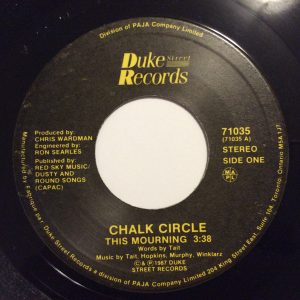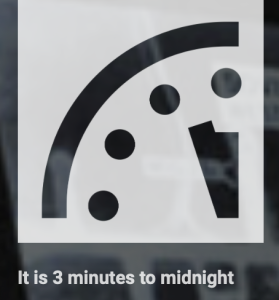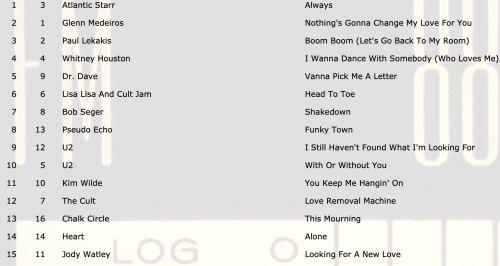#133: This Mourning by Chalk Circle
City: Hamilton, ON
Radio Station: CKOC
Peak Month: November 1987
Peak Position in Hamilton ~ #13
Peak position in Vancouver ~ did not chart
Peak Position on Billboard Hot 100 ~ did not chart
YouTube: “This Mourning”
Lyrics: “This Mourning”
Chalk Circle is a band from Newcastle, Ontario. Its origins grew from a band formed in 1982 called The Casualties. The continuous members were lead singer and guitarist Chris Tait, and bass guitarist Brad Hopkins. The band changed their name to The Reactors, and then to New Addition. In 1984 they became Chalk Circle. The name was taken from Bertolt Brecht’s play The Caucasian Chalk Circle. The play is set in the Soviet Union around the end of WWII. It shows a dispute between two communes, the Collective Fruit Farm Galinsk fruit growing commune and the Collective Goat Farmers. They are arguing over who is to own and manage an area of farm land after the Nazis have retreated from a village and left it abandoned. A parable has been organised by one group, an old folk tale, to be played out to cast light on the dispute. In one part of the play, two women argue over whether a boy named Michael is their own son. A chalk circle is drawn and Michael is placed in the center. The two women are invited to pull Michael out of the chalk circle. If they both pull, they will tear the child in half and get half each? Choosing such a reference for the band’s name, Chalk Circle recorded some interesting songs commenting on contemporary culture.
In addition to Tait and Hopkins, the keyboard, melodica and saxophone player was Tad Winklarz, and Derick Murphy on drums. In 1986, they released a single titled “April Fool”, along with the album, The Great Lake. A minor single, “Me, Myself and I” followed later that year. At the Juno Awards, Chalk Circle received a nomination for Most Promising Group.
In 1987, the band released their second album, Mending Wall. The debut single release was “This Mourning”.

“This Mourning” was written by Chris Tait. The song deals with the nuclear threat of annihilation that was very much part of everyday life in the 1980s.
The lyrics tell us “It’s 11 o’clock.” The Bulletin of the Atomic Scientists created a doomsday clock with the release of the first issue of their journal in 1945. The clock moved from issue to issue depending on world events. Sometimes they moved the clock further away from midnight, and sometimes closer. When the Soviet Union exploded a nuclear device in 1949, the Bulletin of the Atomic Scientists moved the clock to 3 minutes to midnight. In early 1953, the Bulletin wrote “Over the opposition of many nuclear scientists, the United States decides to pursue the hydrogen bomb, a weapon far more powerful than any atomic bomb. In October 1952, the United States tests its first thermonuclear device, obliterating a Pacific Ocean islet in the process. Nine months later, the Soviets test an H-bomb of their own. “The hands of the Clock of Doom have moved again. Only a few more swings of the pendulum, and, from Moscow to Chicago, atomic explosions will strike midnight for Western civilization.” While in 1963, after the Partial Test Ban Treaty was signed by the USA and USSR, the Bulletin moved the clock to 12 minutes to midnight.
In 1984 the Bulletin wrote “As US-Soviet relations reach their iciest point in decades, dialogue between the two superpowers virtually stops. Every channel of communication has been constricted or shut down; every form of contact has been attenuated or cut off. And arms control negotiations have been reduced to a species of propaganda. The United States threatens to provoke a new arms race by seeking a space-based anti-ballistic missile system.”

A 2023 issue of the Bulletin of the Atomic Scientists declared “The Science and Security Board moves the hands of the Doomsday Clock forward, largely (though not exclusively) because of the mounting dangers of the war in Ukraine. The war has raised profound questions about how states interact, eroding norms of international conduct that underpin successful responses to a variety of global risks. The Clock now stands at 90 seconds to midnight—the closest to global catastrophe it has ever been.”
At “11 o’clock” the singer talks with a friend about “the eve of destruction.” This is in reference to the 1965 Barry McGuire chart-topping hit “The Eve of Destruction”. The lyrics open with this timeless verse building a case for arguing the world was on the eve of destruction:
The Eastern world, it is explodin’,
violence flarin’, bullets loadin’.
You’re old enough to kill, but not for votin’,
You don’t believe in war, but what’s that gun you’re totin’?
And even the Jordan River has bodies floatin’
Later Barry McGuire warns about the button the President of the United States can push to launch a nuclear war:
If the button is pushed, there’ll be no running away.
There’ll be no one to save with the world in a grave.
In “This Mourning”, Chris Tait writes “When my head hits the pillow, am I looking up at Ground Zero?” “Ground Zero” has been popularized to reference the site of the World Trade Center attacked on September Eleventh. But in 1987, “Ground Zero” referred to the term that originated with the hypocenter of the Trinity test on July 16, 1945, in Jornada del Muerto desert near Socorro, New Mexico, and the atomic bombings of Hiroshima and Nagasaki, in Japan. The United States Strategic Bombing Survey of the atomic attacks, released in June 1946, used the term liberally, stating, “For convenience, the term ‘ground zero’ will be used to designate the point on the ground directly beneath the point of detonation, or ‘air zero.'”
The Oxford English Dictionary, citing the use of the term in a 1946 New York Times report on the destroyed city of Hiroshima, defines ground zero as “that part of the ground situated immediately under an exploding bomb, especially an atomic one.”
Lyrics to “This Mourning” lament the obliviousness of the general public: “If a man in the street can get to sleep, the city is busy digging graves for counting sheep.” Sometimes, if a person can’t get to sleep, an old custom suggests counting sheep – one sheep, two sheep, three sheep… – until you nod off. But here, the double meaning has the ordinary “man in the street” among the sheep who don’t see what is going on (the nuclear danger we face), and the casual catastrophic risk of mass casualties in a nuclear exchange.
Best Picture winner in 2024, “Oppenheimer”, details the atomic tests in New Mexico which prepared the way for the first atomic bombs to be dropped in Japan in August 1945. The film doesn’t show us the carnage of what happened in Hiroshima or Nagasaki.
“This Mourning” peaked at #13 in Hamilton, #23 in Montreal and reached the Top 30 in Sydney, Nova Scotia.
The band followed up with a cover of a T. Rex single titled “20th Century Boy”.
A third album, As the Crow Flies, was less commercially successful upon release in 1989. Neither of the two tracks released as singles cracked the pop charts in Canada.
After Chalk Circle broke up around 1990, Tait formed the group Big Faith. They released several albums. After the breakup of Big Faith, Tait pursued a career in advertising and promotion with a company that produced jingles. Tait has written music for various ads including the BMW MINI when it was re-launched in Canada in 2002.
In 2003, Tait released a solo album entitled Hello… my name is Chris Tait, which he produced independently in Canada. In 2004, he wrote a song titled “A Little Music” for the annual Coalition For Music Education in Canada promotion “Music Monday”.
Brad Hopkins formed a band called Nothing In Particular. They released one album in 1995.
In 2006 Chalk Circle released the 20th Century Masters best of album and played its first reunion, a sold out show at Lee’s Palace in Toronto. In 2011 the 40th anniversary of the Juno Awards prompted the band to do it again. Events at the Horseshoe Tavern in Toronto featured live performances of Canadian artists from the 70’s, 80’s and the 90’s to celebrate the milestone. Chalk Circle performed on the 80’s night. Blue Peter Keyboardist Jason Sniderman now joins original members Chris, Derrick and Brad to round out the lineup.
May 1, 2024
Ray McGinnis
References:
Liam Lahey, “From chart topper to image maker: Former Chalk Circle singer Chris Tait and the business of making cool,”
Scene and Heard, October 4, 2006.
“The Bulletin – Clock Timeline,” Bulletin of the Atomic Scientists.
Edward Curtin, “Do People Change?,” Off-Guardian, August 13, 2023.
Robert J. Oppenheimer, “Oppenheimer Interview,” 1965.
“The Box bringing Closer Together Tour and Chalk Circle to Pembroke’s Festival Hall,” Pembroke Observer and News, 2022.
Alan Cross, “Chalk Circle: Back Together Yet Again,” A Journal of Musical Things.com, June 6, 2013.
“Chalk Circle – Concert Dates – Canada,” setlist.fm.

CKOC 1150-AM Hamilton (ON) Top 15 | July 15, 1987

Leave a Reply